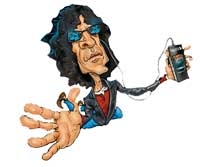Satellite Radio's Big Year Page 2
Get With the Programming So what's the difference between XM and Sirius? Many can't really tell. We're gonna go out on a limb - er, antenna - and say XM's music offerings have a little more depth - for instance, five alternative-music channels vs. Sirius's three, and seven country channels vs. Sirius's five. Sirius has bigger "names" (Howard and Martha) already in place, but let's not forget that XM just landed Dylan and Oprah.
 "We focus on mainstream America," says executive programming VP Eric Logan from XM's corporate headquarters in Washington, DC - where, at 5 p.m., he's finally "lunching" on a candy bar and a bottle of Pepsi. "We pride ourselves on having something for all the different demographics. We've identified the right content mix." Sirius's Clark, on the other hand, claims, "We're more personality-oriented."
"We focus on mainstream America," says executive programming VP Eric Logan from XM's corporate headquarters in Washington, DC - where, at 5 p.m., he's finally "lunching" on a candy bar and a bottle of Pepsi. "We pride ourselves on having something for all the different demographics. We've identified the right content mix." Sirius's Clark, on the other hand, claims, "We're more personality-oriented."
And if you don't like the offerings now, wait 5 minutes. Both providers are unafraid to shake up the channel lineups. "The music space is where the most turnover will happen," says XM's Logan. "If we do our jobs correctly, we'll be 100% reflective of emerging trends."
One trend that can't be disputed is the evolving satellite-radio technology. Brand spankin' new for '06 are XM's 5.1-channel HD Surround broadcasts on its "freeform" Fine Tuning and classical XM Pops channels as well as a number of specials and live music performances around the dial. Denon, Onkyo, Pioneer, and Yamaha all plan to have home theater receivers that can decode the HD Surround signal available by late spring. (Receivers without HD Surround will play these broadcasts in stereo.)
And the future of satellite radio is looking just as multichanneled. Both services plan to offer video - like music clips or cartoons for the kids in the back seat - but it will have to be bandwidth-lite, since lower-frequency satellite radio doesn't have the same huge data capacity as satellite TV. And XM has even demonstrated technology that lets you find out in real time how full a stadium or shopping-mall parking lot is.
When you consider that only roughly one in 30 Americans subscribes to satellite radio, the growth potential is huge. When Logan envisions XM's ultimate success, he admittedly steals a scenario from just about every local-radio professional. "I'd be driving down the road listening to one of my favorite channels. And in the next car, someone will be laughing along with me or singing the same song because they're listening to the same thing on their XM gear. That's the vision I have."
- Log in or register to post comments

























































